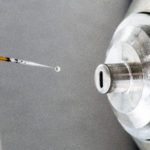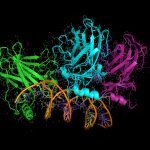Lien vers Pubmed [PMID] – 34108014
Lien DOI – 19110.1186/s13046-021-01988-6
J Exp Clin Cancer Res 2021 Jun; 40(1): 191
Muscle invasive bladder cancer (MIBC) remains amongst the deadliest genitourinary malignancies due to treatment failure and extensive molecular heterogeneity, delaying effective targeted therapeutics. Hypoxia and nutrient deprivation, oversialylation and O-glycans shortening are salient features of aggressive tumours, creating cell surface glycoproteome fingerprints with theranostics potential.A glycomics guided glycoproteomics workflow was employed to identify potentially targetable biomarkers using invasive bladder cancer cell models. The 5637 and T24 cells O-glycome was characterized by mass spectrometry (MS), and the obtained information was used to guide glycoproteomics experiments, combining sialidase, lectin affinity and bottom-up protein identification by nanoLC-ESI-MS/MS. Data was curated by a bioinformatics approach developed in-house, sorting clinically relevant molecular signatures based on Human Protein Atlas insights. Top-ranked targets and glycoforms were validated in cell models, bladder tumours and metastases by MS and immunoassays. Cells grown under hypoxia and glucose deprivation disclosed the contribution of tumour microenvironment to the expression of relevant biomarkers. Cancer-specificity was validated in healthy tissues by immunohistochemistry and MS in 20 types of tissues/cells of different individuals.Sialylated T (ST) antigens were found to be the most abundant glycans in cell lines and over 900 glycoproteins were identified potentially carrying these glycans. HOMER3, typically a cytosolic protein, emerged as a top-ranked targetable glycoprotein at the cell surface carrying short-chain O-glycans. Plasma membrane HOMER3 was observed in more aggressive primary tumours and distant metastases, being an independent predictor of worst prognosis. This phenotype was triggered by nutrient deprivation and concomitant to increased cellular invasion. T24 HOMER3 knockdown significantly decreased proliferation and, to some extent, invasion in normoxia and hypoxia; whereas HOMER3 knock-in increased its membrane expression, which was more pronounced under glucose deprivation. HOMER3 overexpression was associated with increased cell proliferation in normoxia and potentiated invasion under hypoxia. Finally, the mapping of HOMER3-glycosites by EThcD-MS/MS in bladder tumours revealed potentially targetable domains not detected in healthy tissues.HOMER3-glycoforms allow the identification of patients’ subsets facing worst prognosis, holding potential to address more aggressive hypoxic cells with limited off-target effects. The molecular rationale for identifying novel bladder cancer molecular targets has been established.


